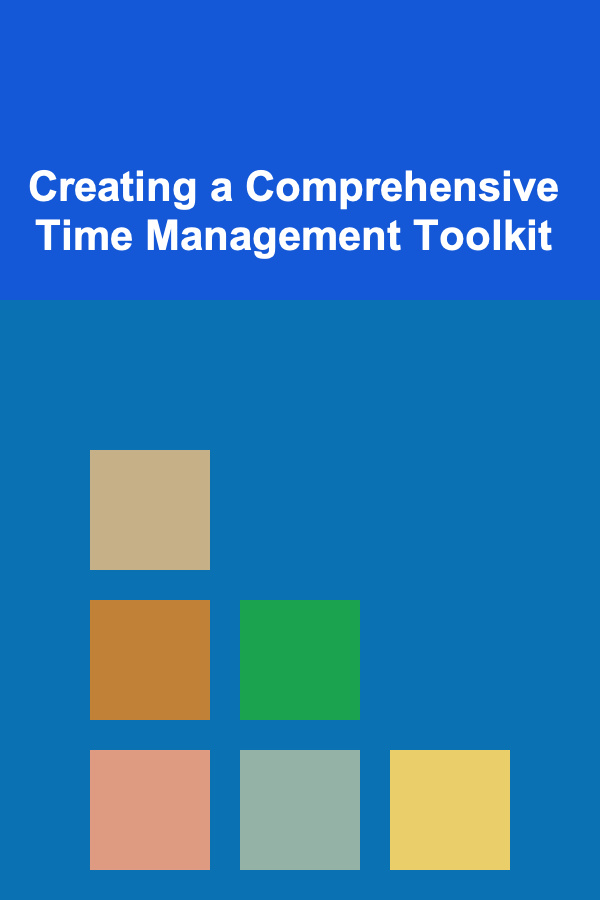
Creating a Comprehensive Time Management Toolkit
ebook include PDF & Audio bundle (Micro Guide)
$12.99$9.99
Limited Time Offer! Order within the next:

In today's fast-paced world, effective time management is no longer a luxury; it's a necessity. Whether you're a student, a professional, an entrepreneur, or simply someone striving for a more balanced life, mastering your time can significantly enhance productivity, reduce stress, and improve overall well-being. This article provides an in-depth guide to creating a personalized time management toolkit, equipping you with the strategies, techniques, and tools to take control of your day and achieve your goals.
Understanding the Foundation: Why Time Management Matters
Before diving into specific tools and techniques, it's crucial to understand the underlying principles and benefits of effective time management. It's not just about cramming more tasks into a day; it's about working smarter, not harder.
The Core Benefits of Time Management
- Increased Productivity: Efficient time management allows you to focus on the most important tasks, leading to higher output and better quality work.
- Reduced Stress and Anxiety: Knowing what needs to be done and having a plan to accomplish it minimizes feelings of being overwhelmed and stressed.
- Improved Decision-Making: When you're not rushing against the clock, you can make more thoughtful and informed decisions.
- Better Work-Life Balance: Effective time management helps you prioritize tasks and allocate time for both professional and personal activities, leading to a more fulfilling life.
- Achieving Goals Faster: By breaking down large goals into smaller, manageable tasks and scheduling time for them, you increase your chances of success.
Identifying Your Time Management Challenges
Everyone faces unique time management challenges. The first step in building your toolkit is to identify what's holding you back. Some common challenges include:
- Procrastination: Delaying tasks, often due to fear of failure or lack of motivation.
- Poor Prioritization: Difficulty distinguishing between urgent and important tasks, leading to wasted time on less critical activities.
- Interruptions and Distractions: Constant interruptions from emails, social media, and colleagues disrupting focus and workflow.
- Lack of Planning: Starting the day without a clear plan, leading to reactive rather than proactive work.
- Perfectionism: Spending too much time on minor details, hindering progress on more important tasks.
- Multitasking: Attempting to juggle multiple tasks simultaneously, resulting in reduced efficiency and increased errors.
Take some time to honestly assess your current time management habits. Where do you struggle the most? What are your biggest time-wasters? Understanding your weaknesses will help you tailor your toolkit to address your specific needs.
Building Your Time Management Toolkit: Key Components
A comprehensive time management toolkit should include a variety of strategies, techniques, and tools to address different aspects of your time management challenges. Here's a breakdown of the essential components:
1. Goal Setting and Prioritization
Effective time management starts with clear goals and priorities. Without knowing what you want to achieve, it's impossible to allocate your time effectively.
a. SMART Goals
Use the SMART framework to define your goals. SMART stands for:
- Specific: Clearly define what you want to achieve.
- Measurable: Establish criteria for measuring progress.
- Achievable: Set realistic and attainable goals.
- Relevant: Ensure your goals align with your overall objectives.
- Time-bound: Set a deadline for achieving your goals.
For example, instead of saying "I want to write more," a SMART goal would be "I will write for 30 minutes every day for the next month, resulting in a 10,000-word draft of my novel."
b. Prioritization Techniques: The Eisenhower Matrix (Urgent/Important)
The Eisenhower Matrix, also known as the Urgent/Important Matrix, is a powerful tool for prioritizing tasks. It categorizes tasks into four quadrants:
- Quadrant 1: Urgent and Important (Do First): These are crises, emergencies, and deadlines that require immediate attention.
- Quadrant 2: Important but Not Urgent (Schedule): These are activities that contribute to long-term goals, such as planning, exercise, and relationship building. Focus the majority of your time here.
- Quadrant 3: Urgent but Not Important (Delegate): These are interruptions and distractions that demand attention but don't contribute to your goals. Delegate these tasks if possible.
- Quadrant 4: Not Urgent and Not Important (Eliminate): These are time-wasting activities that should be eliminated altogether.
Regularly review your tasks and categorize them using the Eisenhower Matrix. Focus your energy on Quadrant 2 tasks to prevent problems before they become urgent. Learn to say "no" to tasks in Quadrants 3 and 4.
c. The Pareto Principle (80/20 Rule)
The Pareto Principle states that roughly 80% of your results come from 20% of your efforts. Identify the 20% of your tasks that generate the most significant results and prioritize them accordingly. Focus on these high-impact activities to maximize your productivity.
2. Planning and Scheduling
Once you have your goals and priorities in place, the next step is to create a plan and schedule to allocate your time effectively.
a. Time Blocking
Time blocking involves dividing your day into specific blocks of time for different activities. Allocate dedicated time slots for tasks, meetings, and even breaks. This helps you stay focused and prevents tasks from being neglected.
Use a calendar (digital or physical) to schedule your time blocks. Be realistic about how long each task will take and factor in buffer time for unexpected events.
b. Task Management Tools
Task management tools can help you organize, track, and prioritize your tasks. There are numerous options available, both digital and analog. Some popular digital tools include:
- Todoist: A versatile task manager with features like recurring tasks, subtasks, and collaboration.
- Trello: A visual task management tool using Kanban boards to organize tasks into stages of completion.
- Asana: A project management tool suitable for both individual and team use.
- Microsoft To Do: A simple and intuitive task manager integrated with Microsoft Outlook.
- Google Tasks: A basic task manager integrated with Google Calendar and Gmail.
Analog options include:
- Planners: Physical planners with daily, weekly, or monthly layouts for scheduling and task tracking.
- Bullet Journals: A customizable journal system for organizing tasks, notes, and ideas.
- Sticky Notes: A simple way to jot down tasks and move them around on a whiteboard or wall.
Experiment with different tools to find one that suits your workflow and preferences.
c. Daily, Weekly, and Monthly Planning
Effective planning involves looking at your schedule from different perspectives:
- Daily Planning: At the end of each day or the beginning of the next, review your tasks and prioritize them for the day ahead.
- Weekly Planning: On a weekly basis, review your goals for the week and schedule time for key activities.
- Monthly Planning: At the start of each month, review your long-term goals and break them down into smaller, actionable steps for the month.
Regular planning helps you stay on track and ensures that your daily activities align with your overall goals.
3. Focus and Concentration
Even with the best plans, distractions can derail your productivity. Developing strategies to enhance focus and concentration is crucial.
a. The Pomodoro Technique
The Pomodoro Technique is a time management method that involves working in focused bursts of 25 minutes, followed by a 5-minute break. After four "pomodoros," take a longer break of 20-30 minutes.
This technique helps you maintain focus and prevents burnout. Use a timer or app to track your pomodoros.
b. Timeboxing
Timeboxing is similar to time blocking, but it's more focused on allocating a specific amount of time to a particular task, regardless of whether you finish it or not. Set a timer and work on the task until the timer goes off. This encourages you to stay focused and avoid perfectionism.
c. Minimizing Distractions
Identify your biggest distractions and take steps to minimize them. This might involve:
- Turning off notifications: Disable email, social media, and other notifications that interrupt your focus.
- Using website blockers: Block distracting websites during work hours. Examples include Freedom, Cold Turkey, and StayFocusd.
- Creating a dedicated workspace: Designate a quiet and distraction-free area for working.
- Communicating your availability: Let colleagues and family members know when you need uninterrupted time.
- Using noise-canceling headphones: Block out external noise to improve concentration.
d. Mindfulness and Meditation
Practicing mindfulness and meditation can improve your focus and reduce stress. Even a few minutes of daily meditation can help you become more aware of your thoughts and emotions, making it easier to stay present and focused.
4. Delegation and Outsourcing
You don't have to do everything yourself. Delegating tasks to others or outsourcing them to external providers can free up your time for more important activities.
a. Identifying Delegatable Tasks
Identify tasks that you can delegate to others without compromising quality. These might be administrative tasks, routine tasks, or tasks that someone else can do more efficiently.
b. Effective Delegation
When delegating, be clear about the task, the expected outcome, and the deadline. Provide the necessary resources and support to help the person succeed. Trust them to do the job and avoid micromanaging.
c. Outsourcing
Consider outsourcing tasks to freelancers or virtual assistants. Websites like Upwork, Fiverr, and TaskRabbit offer a wide range of services at competitive prices. Outsourcing can be particularly helpful for tasks that are time-consuming or outside of your area of expertise.
5. Review and Adjustment
Your time management toolkit is not a static entity. It's important to regularly review your strategies and adjust them as needed.
a. Weekly Review
At the end of each week, review your progress and identify what worked well and what didn't. Did you achieve your goals for the week? Were there any unexpected challenges? What can you do differently next week?
b. Monthly Review
On a monthly basis, review your long-term goals and assess your progress. Are you on track to achieve your goals? Do you need to adjust your strategy? Are there any new opportunities or challenges that you need to address?
c. Experimentation and Adaptation
Don't be afraid to experiment with different time management techniques and tools. What works for one person may not work for another. Find what works best for you and adapt your toolkit to your specific needs and circumstances.
Essential Tools for Your Toolkit
While the specific tools you choose will depend on your individual preferences, here are some essential categories to consider:
- Calendar: A digital or physical calendar for scheduling appointments, meetings, and tasks. Google Calendar, Microsoft Outlook Calendar, and Apple Calendar are popular digital options.
- Task Manager: A tool for organizing, tracking, and prioritizing tasks. Todoist, Trello, Asana, and Microsoft To Do are excellent digital choices. Physical planners and bullet journals are great analog alternatives.
- Note-Taking App: A tool for capturing ideas, taking notes, and organizing information. Evernote, OneNote, Google Keep, and Notion are popular options.
- Timer: A timer for implementing the Pomodoro Technique or timeboxing. There are many free timer apps available for smartphones and computers.
- Website Blocker: A tool for blocking distracting websites during work hours. Freedom, Cold Turkey, and StayFocusd are effective options.
- Focus App: Apps designed to enhance focus and concentration, often incorporating features like ambient noise, website blocking, and task management. Examples include Forest and Serene.
The Importance of Self-Care in Time Management
It's crucial to remember that effective time management also includes taking care of your physical and mental well-being. Burnout can significantly impact your productivity and overall quality of life.
Prioritizing Rest and Relaxation
Schedule time for rest and relaxation. This might involve taking breaks during the day, getting enough sleep, engaging in hobbies, or spending time with loved ones.
Maintaining a Healthy Lifestyle
Eat a healthy diet, exercise regularly, and stay hydrated. These habits can improve your energy levels, focus, and overall well-being.
Practicing Mindfulness and Stress Reduction
Engage in activities that help you manage stress, such as meditation, yoga, or spending time in nature.
Conclusion: Mastering Your Time, Mastering Your Life
Creating a comprehensive time management toolkit is an ongoing process. It requires self-awareness, experimentation, and a willingness to adapt your strategies to your changing needs. By understanding the principles of effective time management, identifying your challenges, and utilizing the tools and techniques outlined in this article, you can take control of your time, increase your productivity, reduce stress, and achieve your goals. Remember, mastering your time is not just about getting more done; it's about living a more fulfilling and balanced life.

How to Incorporate Sustainable Decor into Your Home on a Budget
Read More
How to Keep Your Home Clean with Kids and Pets Around
Read More
How to Set Up a Routine for Restocking Pet Supplies
Read More
How to Understand the Future Trends in Print-on-Demand
Read More
How To Master Frugal Entertaining at Home
Read More
How to Embrace Minimalism for Mental Clarity
Read MoreOther Products

How to Incorporate Sustainable Decor into Your Home on a Budget
Read More
How to Keep Your Home Clean with Kids and Pets Around
Read More
How to Set Up a Routine for Restocking Pet Supplies
Read More
How to Understand the Future Trends in Print-on-Demand
Read More
How To Master Frugal Entertaining at Home
Read More